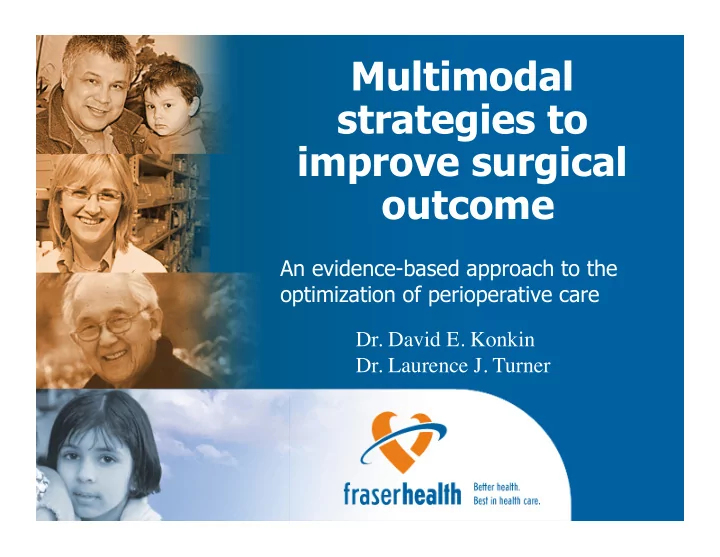

Multimodal strategies to improve surgical outcome An evidence-based approach to the optimization of perioperative care Dr. David E. Konkin Dr. Laurence J. Turner
Multimodal strategies to improve surgical outcome
Multimodal strategies to improve surgical outcome Lancet 362:1921-28, 2003
Factors contributing to perioperative morbidity BMJ 2001;322:473-476 Kehlet, et al. (September, 2007). “Fast Track Surgery” Workshop Hvidovre University Hospital, Copenhagen, Denmark
Interventions to improve surgical outcome Pre-op information / psychological preparation • Assess and optimize medical condition • Neuraxial blockade • Maintain temperature and oxygenation • Minimally invasive procedures • Nausea and ileus prevention • Opioid sparing analgesia • Early feeding and ambulation • Disturbance-free rest time • Evidence-based post-op care (avoid drains, remove catheter) • Monitor outcomes •
Kehlet’s “Fast Track Surgery” Principles Leads to ↓ Hospital stay ↓ Convalescence especially fatigue BMJ 2001;322:473-476 *** Single modal treatment for a multimodal problem is futile*** Kehlet, et al. (September, 2007). “Fast Track Surgery” Workshop Hvidovre University Hospital, Copenhagen, Denmark
Organization for optimal care • Assemble multi-disciplinary group • Outline plan for specific procedures (start simple) • Develop pain management programs • Adjust care to evidence-based standards • Develop patient information resources • Develop nursing care plan (pathway) • Document outcomes and patient feedback • Review, revise and improve pathway
Team members • Pre-admission clinic staff • Anaesthesiologist / pain management team • Surgeon(s) • Nursing staff (OR and ward) • Nutritionist • Physiotherapist • Pharmacist
Prof Henrik Kehlet Workshop on Fast-track colonic surgery. Hvidovre Hospital, Copenhagen, Denmark. September 25-26, 2007
AIM Statement • Implement an evidenced-based rapid recovery program based on Reimer-Kent’s “Postoperative Wellness Model” and Kehlet’s “Fast Track Surgery” principles and designed to optimize surgical outcome and support a rapid surgical recovery, namely by: – Minimizing pain and suffering – Normalizing GI Function – Minimizing preoperative starvation – Feeding postoperatively ASAP – Minimizing inactivity – Discontinuing attached lines, tubes &/or drains ASAP – Promoting self-care – Optimizing respiratory function To achieve these outcomes, practice needed to change
Methods • Retrospectively review • Fast-track (2007/2008) = 77 • Historical controls (2005) = 111
Demographics Control Fast-track N 111 77 Age 61.9 62.7 Male Gender 62.2% 46.0% ASA Class 1.9 2.4 Comorbities DM 20.7% 12.1% COPD 18.0% 8.1% Cardiac 26.1% 33.8% Renal 7.2% 6.8%
Procedure Control Fast-track R hemicolectomy 15.3% 35.1% Ant resection 53.2% 33.8% APR 15.3% 10.8% Takedown ileostomy 0 1.3% Hartmann's reversal 0 2.7% Colostomy 26.1% 18.9% Video-assisted 10.8% 24.3%
Clear Fluids Goal: Avoid Clear Fluid Diet
Full Fluids Goal: Start Full Fluid Diet by POD#1 Breakfast Average: 4.2 +/- 3.7 1.9 +/- 5.8 p < 0.01
Regular Diet Goal: Start Regular Diet by POD#2 Average: 5.5 +/- 3.7 3.9 +/- 6.0 p < 0.01
BM Goal: 1 st Bowel Movement by POD#3 Average: 3.3 +/- 2.2 2.2 +/- 1.4 p < 0.01
T3 use Goal: No Acetominophen with codeine
Regular Acetaminophen Goal: Acetaminophen Around-the-Clock POD# 1 – 7 – If no liver disease
Regular NSAIDs Goal: NSAIDs Around-the-Clock POD# 1 – 5 – If no PUD, eGFR > 60
Epidural Goal: Remove Epidural by POD# 2 If pain controlled with oral analgesics Average: 4.4 +/- 4.0 2.2 +/- 1.0 p < 0.01
Urinary Catheter Goal: Remove Urinary Catheter by POD#2 Average: 5.1 +/- 4.3 2.5 +/- 2.3 p < 0.01
Ambulation Goal: Walk Unassisted by POD#2 Average: 4.4 +/- 4.4 2.2 +/- 2.3 p < 0.01
Discharge Goal: Discharge by POD# 4 If all discharge criteria met Average: 12.8 +/- 13.4 7.8 +/- 7.5 p < 0.01
Conclusion • Rapid surgical recovery is attainable • Optimizing perioperative care with multimodal strategies to improve surgical care • Improve quality of care
Barriers to implementation British J Surgery 95; 807, June 2008
Barriers to implementation • Lack of understanding of purpose • Lack of knowledge • Traditions • Resources • Lack of administrative support • “the practical reality of the bedside”
Future Directions • Implementation Maintenance • Further data collection, including follow-up • Distribution of knowledge • Further spread – RCH General Surgery • new “default” standard of care in regardless of procedure type – Fraser Health Authority – Province-wide
Acknowledgements • J Reimer-Kent • Dr.’s NP Blair, M Bojm, R Granger, A Kamatakahara, R Van Heest
Recommend
More recommend